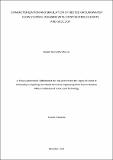| dc.description.abstract | The pattern, organization and hierarchy of nested groundwater flow systems, albeit complex,
their understanding is very crucial for informed groundwater resources development and
management. This study sought to characterize and simulate the impacts of varying climate and
anthropogenic influences on the nested groundwater flow systems and the spatio-temporal
association of nested groundwater flow systems, utilizing real field test cases of Singida semi-
arid fractured aquifer and the Kimbiji coastal, humid sedimentary aquifer in Tanzania.
Groundwater flow modelling and simulation of nested groundwater flow systems was carried
out using the USGS finite difference modelling code (MODFLOW 6), utilizing ModelMuse
version 5 as the Graphical User Interface (GUI). Hydrogeochemical and isotopic signature
analyses complemented the modelling approach. The comparison of isotopic composition from
borehole, rivers, lakes and rainfall showed that generally, boreholes in the Kimbiji aquifer and
some in the Singida aquifer had depleted isotopic values and enriched isotopic values were in
samples from open water bodies (e.g., rivers and lakes). The depletion was prominently so in
the deep boreholes, indicating a limited influence of evaporation during groundwater recharge.
Regional flow fluxes make up 74% of the total inflows into the Kimbiji coastal Neogene
aquifer, and only 26% of the inflows are made up of the local flow systems. In the Singida
aquifer, regional flow accounts for 56% of the total flux in the lower aquifer and makes 94%
contribution to the total amount of groundwater inflow in the Singida aquifer. Only 6% of the
groundwater storages comes from local recharge and other sources like lakes. The effect of land
cover change dynamics on groundwater recharge has been more prominent in the Kimbiji
aquifer, while the effect of climate varying (rainfall and temperature) featured more
prominently in the Singida semi-arid aquifer. Dependence of local recharge on heavy rainfalls
is one of the key features of the Singida aquifer, while local recharge in the Kimbiji aquifer is
quasi-uniform, occurring at more or less similar rate, albeit decreasing with decreasing rainfall
amounts and increasing surface temperature, and thus evapotranspiration. Local flow system
fluxes were observed to be the main feeders for the upper unconfined aquifers in the two study
areas, while regional flow systems are for the deep semi-confined aquifers, with appreciable
exchanges of water as revealed by nested groundwater flow simulation. The study findings will
contribute to various global, regional and local technical and policy-based efforts towards
sustainable groundwater development and management, considering climate variability and
non-climatic factors. This includes the contribution to Sustainable Development Goals (SDGs),
particularly SDG on access to clean water and sanitation | en_US |

